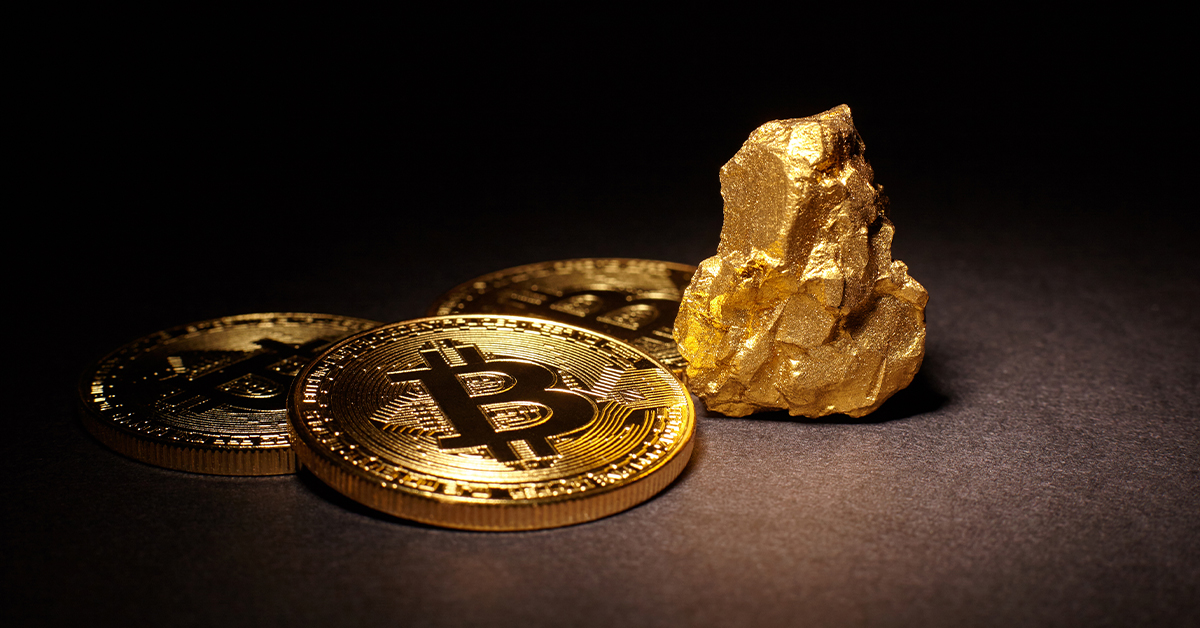There has recently been a lot of discussion and debate around the possible similarities and differences of gold and Bitcoin (and, by implication, other cryptocurrencies), and this has often included consideration of their relative environmental impacts and, specifically, their carbon footprints.
At one level, a comparison of the relative carbon footprints of gold and cryptocurrencies is justified because the emissions of both are primarily related to the electricity used in their production. But I find shifting from this point to wider comparisons - for example, regarding the carbon intensity of their relative values or their social and environmental impacts - to be more problematic.
My colleagues have said it before; gold and cryptocurrencies are simply very different as assets. But their clear and rational description of those differences (see, for example, How gold’s role in a portfolio differs from cryptocurrencies) didn’t touch upon the social and environmental impacts of gold and cryptos, and I therefore thought a little further examination and comment on those aspects of potential comparison might be warranted.
Looking first at the respective electricity consumption and emissions of gold mining and crypto ‘coin’ mining, a quick glance might reinforce the idea that a comparison is justified. If we compare large-scale, industrialised gold mining and the two major crypto currency networks (Bitcoin and Ethereum), there does currently appear to be a close similarity in the scale of their electricity consumption and associated emissions. A few high-level calculations suggest gold and cryptocurrencies currently share a broadly similar emissions profile, with total emissions of roughly, between 60 and 70 million tonnes of CO2e per annum.
However, this apparent similarity of scale is likely fleeting and coincidental. It may well be out of date by the time this is published. The opacity and extreme volatility of the crypto space make any indicative ‘snapshot’ a statistical challenge and likely to change in a matter of days. The CBECI’s1 current measure of the electricity consumption of Bitcoin (BTC), for example, includes theoretical ‘upper bound’ estimates that are currently 127% higher than its average/base estimate figures; until last week or so, that difference was over 240%.
This is another telling difference between the two. Data on cryptocurrency inputs and emissions is limited and patchy, and estimates require a lot of assumptions and extrapolations. The gold mining sector, on the other hand, has made great progress in its climate-related disclosures and we have therefore been able to produce detailed estimates of gold mining’s sectoral emissions. We have also been able to define, in some detail, what gold’s potential pathway to Net Zero will look like in practice. That is, we have mapped out how specific moves to renewable power sources at mine sites, supported by less production from higher emissions mines, can contribute to decarbonisation aligned with Paris Agreement targets.2
Unfortunately, there is no such clearly defined pathway for the crypto currency sector. Or, rather, there is no clear agreement on whether such a path will be one the industry chooses to follow.
It is worth noting here, however, that both gold and crypto mining will undoubtedly benefit from projected reductions in the emissions intensity of grid power. Indeed, as few cryptocurrency operations are responsible for their own power generation, they are almost wholly dependent on the evolution of grid-sourced electricity and its ability to shift to renewable sources.
But this dependency is also a major weakness for cryptos. The industry’s ‘passivity’ in the face of climate change is insufficient to allow observers or stakeholders any confidence in its ability or commitment to transition. And, while coin miners have been significant users of renewable power, it is not clear whether this has simply reflected the tactical pursuit of the cheapest electricity from localised surplus renewable power, often remotely located or not yet adequately integrated into wider distribution systems. That certainly appears to have been the case in China, where hydro power has frequently been the prevalent source of electricity but often due to seasonal cost advantages, rather than evidence of any strategic commitment to decarbonise power. As Jack Liao, CEO of Chinese crypto mining company LightningAsic, recently commented (whilst suggesting governments might incentivise firms such as his to move to renewable power sources), “Every miner’s objective is making a profit, so they don’t care about what kind of energy they use, if it is generated by hydro, wind, solar or burning coal."3
Data on cryptocurrency inputs and emissions is limited and patchy, and estimates require a lot of assumptions and extrapolations. The gold mining sector, on the other hand, has made great progress in its climate-related disclosures and we have therefore been able to produce detailed estimates of gold mining’s sectoral emissions.
Gold mining has made a demonstrable effort to address these issues, and a commitment to combating climate change, via emissions reduction, is embedded in the Responsible Gold Mining Principles. In addition to decarbonising its power sources, the industry has also committed to increased energy efficiency initiatives to further drive down both emissions and costs.
The crypto sector, however, has yet to demonstrate any direction in such sectoral leadership or industry consensus, and this is a major challenge to any concerted industry attempts to move towards greener practices. Although we have recently seen crypto enthusiasts like Elon Musk trying to nudge the industry towards collaboration, the inherently decentralised, ‘permissionless’ nature of the crypto mining business seems a substantial potential stumbling block to progress.
But the reluctance to widely commit to cleaner power may also stem from the direct and intrinsic relationship between cryptocurrency power consumption and value.4 As Arvind Narayanan, Associate Professor of Computer Science at Princeton University, told a US Senate committee, “Roughly speaking, if the price of a cryptocurrency goes up, more energy will be used in mining it; if it goes down, less energy will be used. Little else matters. In particular, the increasing energy efficiency of mining hardware has essentially no impact on energy consumption.”5
Gold’s power consumption and associated emissions are, of course, not price dependent and, from a value perspective, the carbon footprint of, for example, each dollar invested in gold diminishes as the price of gold rises. From an investor perspective, this is an important consideration.
Another key question for investors considering the sustainability impacts of their holdings is the question of the appropriate use of resources with specific purposes or beneficial impacts in mind. And therein lies a substantial problem with cryptocurrencies; their utility is yet to be demonstrated.
I recently read a defence of BTC and its seemingly unquenchable thirst for electricity that included a statement suggesting it was, almost inevitably, difficult to gauge what the environmental footprint of a ‘new monetary system’ should be. Similarly, a ‘myth-busting’ piece (authored by SatoshiLabs, creators of leading crypto wallet hardware) on BTC’s power consumption, recently asserted the purpose of cryptos is to create “an alternative world of money”.6
But such claims are, at best, premature and don’t necessarily articulate the particular problems that are potentially to be solved by this ‘new system’ and ‘alternative world’.
The world of digital currencies and frictionless payment systems are rapidly evolving, but I have seen little firm indication that cryptocurrencies, at least in their prevailing form, are central to those developments (beyond, perhaps, helping drive technological progress).
As things stand, I think the basic concept of cryptocurrencies as money can be challenged, not least as money needs a degree of stability if it is to function as a widely accepted medium of exchange and a reliable store of value.
And price volatility may be the speculator’s potential friend, but the extremes exhibited by cryptos - higher by a factor of five or six times than gold or global equities7 - make it simply far too precarious a ride for investors seeking to protect their capital or ensure they can meet long-term liabilities.
Also, the assertion that cryptos offer diversification and hedging capabilities, comparable to gold, was punctured by recent analysis from MSCI which indicated that cryptos offered relatively little downside protection against equity weakness.8
Without a strong demonstrable purpose or function, the question of whether cryptocurrencies justify such a voracious use of resources will always be challenging.
Without a strong demonstrable purpose or function, the question of whether cryptocurrencies justify such a voracious use of resources will always be challenging. I am thinking not only of electricity here, but also the computer components that comprise crypto mining rigs. These units now have a short average life of 1.5 years, which can threaten other supply chains – for example, creating or exacerbating semiconductor shortages - and generate very large amounts of e-waste. Few crypto companies appear to have yet built any degree of circularity or recycling into their operations.9
Of course, gold mining has a range of environmental impacts too, and many of them are substantial and disruptive, but the industry has made great strides in seeking to mitigate them via adherence to responsible and sustainable practices and standards. And the gold supply chain’s wider positive social and economic impacts, direct and indirect, can be very significant10 – touching the lives of millions, well beyond the gold mine or those fortunate enough to own gold.
Putting aside the very different investment profiles of gold and cryptocurrencies, I suggest that until the latter can demonstrate a diverse set of uses and positive impacts, underpinned by an industry seeking to elevate social, economic and environmental standards, we might forget the comparisons for now.


